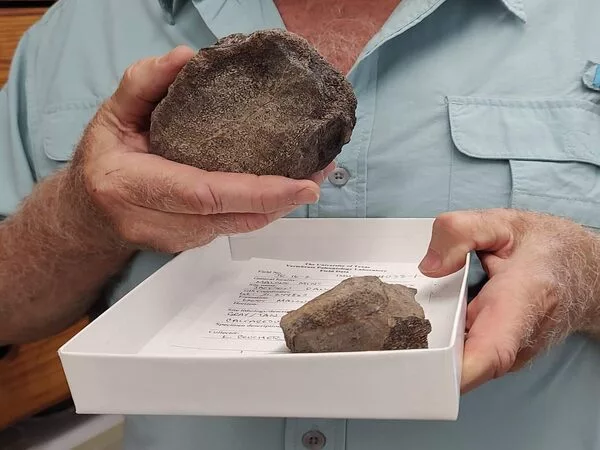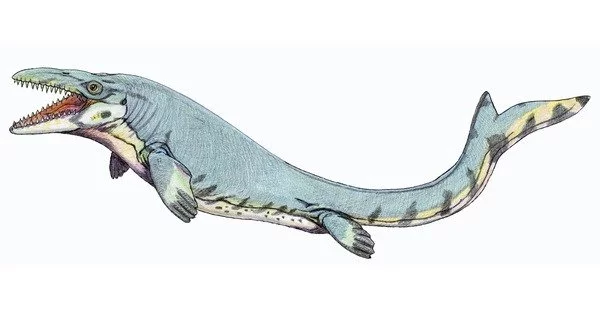Palaeontologists and researchers frequently uncover new fossils in many sites around the world, including Texas. Texas is well-known for its extensive fossil record, particularly from the Cretaceous period, but also from the Jurassic and other geological eras.
A team led by scientists at The University of Texas at Austin has filled a significant gap in Texas’ fossil record by reporting the state’s earliest known Jurassic vertebrate fossils. The weathered bone fragments are from the limbs and backbone of a plesiosaur, an ancient marine reptile that would have swum around 150 million years ago in the shallow sea that encompassed what is now northeastern Mexico and far western Texas.
The bones were discovered in the Malone Mountains of West Texas during two fossil hunting expeditions conducted by Steve May, a research associate at UT Austin’s Jackson School of Geosciences Museum of Earth History. Prior to the finding, the only Jurassic fossils found and documented from Texas outcrops were marine invertebrates such as ammonites and snails. According to May, the new fossil discoveries prove that Jurassic bones exist.
Geologists are going to go out there looking for more bones. They’re going to find them, and they’re going to look for the other things that interest them in their own special ways.
Dr. Jacobs
“Folks, there are Jurassic vertebrates out there,” May added. “We found some of them, but there are more to be discovered that can tell us about what this part of Texas was like during the Jurassic period.”
The bones and other fossils were described in a study published in Rocky Mountain Geology. The Jurassic Period was a famous prehistoric period when enormous dinosaurs roamed the Earth. We only know about them and other Jurassic life because of the fossils they left behind.
However, in order to uncover Jurassic-aged fossils, Jurassic-aged rocks are required. Because of Texas’ geological history, there are few outcrops from this period in Earth’s history. The Malone Mountains’ 13 square miles of Jurassic-aged rocks account for the majority of the state’s rocks.
When May discovered that there were no Jurassic bones in the Texas fossil record while researching a book in 2015, he decided to go to the Malone Mountains to investigate. “You just don’t want to believe that there are no Jurassic bones in Texas,” May said. “Plus, there was a tantalizing clue.”

Claude Albritton, who subsequently became a geology professor at Southern Methodist University (SMU), mentioned massive bone fragments in a 1938 paper on the geology of the Malone Mountains. It was enough of a lead for May and his colleagues to travel to West Texas and witness for themselves. They discovered large bone fragments. Plesiosaur fossils have been degraded and broken up. But it’s a start that could lead to more research, according to co-author and SMU professor emeritus Louis Jacobs.
“Geologists are going to go out there looking for more bones,” Jacobs said. “They’re going to find them, and they’re going to look for the other things that interest them in their own special ways.” Today, the Malone Mountains rise above the dry desert landscape. During the Jurassic, the sediments were deposited just below sea level probably within miles of the shoreline.
The scientists discovered several more specimens that provide insight into the ancient shallow marine environment, such as petrified driftwood riddled with burrows from marine worms and the shells of clams, snails, and ammonites. The researchers discovered a variety of plant fossils, including a pinecone and wood with probable growth rings.
According to co-author and paleobotanist Lisa Boucher, head of the Jackson School’s Non-Vertebrate Palaeontology Lab, Jurassic plant fossils from lower latitudes near the Earth’s equator are rather rare globally. She believes that the plant discoveries will pique the curiosity of other paleobotanists and those interested in paleoenvironmental reconstruction.
For nearly a century, scientists have been doing study in the Malones. So, what took so long to recover Jurassic bones? May has numerous ideas, ranging from the remoteness of the place and permits to earlier scientists’ study objectives. Whatever the reasons, Boucher believes the team’s finding of a Texas first demonstrates the importance of field work – simply travelling to a location to see what’s there.
“It’s frequently part of the scientific process,” added Boucher. “There are a few sentences buried in an old magazine that you think,’surely somebody has already looked at that,’ but they haven’t always. You should look into it.”
















